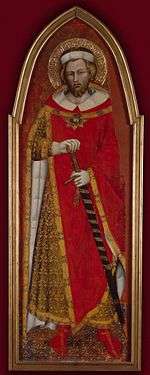Pontianus of Spoleto
| Saint Pontianus | |
|---|---|
|
| |
| Martyr | |
| Born | c. 156 |
| Died |
14 January 175 Spoleto, Italy, Roman Empire |
| Venerated in | Roman Catholic Church (Spoleto, Italy; and Utrecht, Netherlands) and the Old Catholic Church |
| Canonized | pre-congregation |
| Major shrine | Basilica of San Ponziano, Spoleto, Italy |
| Feast | 19 January (14 January in Spoleto) |
| Attributes | young man holding a sword |
| Patronage | Spoleto, Italy, and Utrecht, Netherlands |
All that is known of Pontianus (Italian: Ponziano) is that he was a Christian who was martyred during the reign of the Emperor Marcus Aurelius. He is honored as a saint and martyr by both the Catholic Church and the Old Catholic Church. In Spoleto, Italy, he is invoked for protection against earthquakes.
Life
According to a Passio preserved in the Cathedral of Spoleto,<ref name=FSP /[1] Pontianus was a young man from a local noble family of Spoleto, 18 years of age, who had been denounced as a Christian to the Roman authorities. Brought before a judge named Flavian, he chose torture and death rather than renounce his faith. He was condemned to death and beheaded on 14 January 175. <ref name=SB /[2]
Veneration
Basilica of San Ponziano
Pontianus' body was buried in the local cemetery, called di Sincleta, outside the city walls. The Basilica of San Ponziano was eventually built over his grave as a shrine to his memory.[3] He has become the patron saint of that city.[4] A monastery was built attached to the basilica for a community of Bendictine monks to administer it. Over the centuries, the monks were replaced by nuns of the same order. The monastery was suppressed in 1810 during the occupation of Italy by Napoleonic forces.[5]
Every year a festival is held in the city to honor Pontianus, its patron. Various services are held starting on the eve of the feast, which culminate in a procession through the streets of the city. Pontianus' skull, preserved in the basilica, is processed for veneration by the people of the city.[6]
Today the complex of basilica and monastery is operated by a community of Canonesses Regular of the Lateran.[7] The canonesses operate the ancient monastery as a religious guesthouse, open to all.[8]
Patron saint of Utrecht
Devotion to Pontianus grew throughout the region. In 966, Bishop Balderic of Utrecht travlled to Rome to present an account of his administration, as required by Church law. He took the opportunity to tour various churches and monasteries, from which he obtained numerous relics of the saints for the churches of his diocese. In the course of this journey, he obtained one of Pontianus' arms, which he had enshrined in his cathedral. As a result, Pontianus was named a co-patron of the diocese.
At the time that the Protestant Reformation took hold in Utrecht, Calvinist mobs attacked the Catholic cathedral there. Members of the Old Catholic Church, headquartered in that city, sought to protect his relics, which they were given and then preserved.
In 1994 the Primate of the Old Catholic Church returned this relic in a solemn manner to the abbess of the monastery which administers the basilica.[9]
Protection against earthquakes
In Spoleto, Pontianus is invoked for protection against earthquakes. This developed from an ancient tradition that, before his death, the young martyr had predicted that "Spoleto will shake but not will collapse".
In 1703, the first of a series of devastating earthquakes occurred on his feast day. It affected the entire region of Italy, lasting nearly three weeks. While thousands of people died as a result, there were no deaths in Spoleto.
Artwork
Pontianus is one of the 140 saints whose statues adorn St. Peter's Square on top of Bernini's colonnades.
Notes
- ↑ "Festa di S. Ponziano, patrono di Spoleto". Archidiocesi di Spoleto-Norcia (in Italian). 14 January 2013.
- ↑ "Santi e Beati della Diocesi". Archidiocesi di Spoleto-Norcia (in Italian).
- ↑
- ↑ St. Pontianus Catholic Online
- ↑ "Chiesa e Monastero di San Ponziano - Secoli XII-XIII". Comune di Spoleto (in Italian).
- ↑
- ↑ "Monache Canonichesse Regolari Lateranensi". Archidiocesi di Spoleto-Norcia (in Italian).
- ↑ "La struttura". Casa religiosa di ospitalità San Panziano (in Italian).
- ↑ "Saint Ponziano of Spoleto". Saints.SPQN.com.
